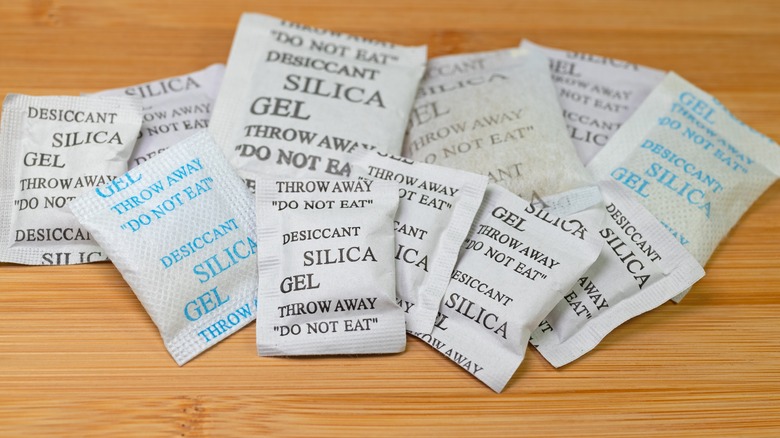Are Ryobi Batteries Waterproof? What To Do If You Leave One Out In The Rain
Power tool batteries have come a long way in terms of power, safety, and efficiency. They're also fairly expensive, so you want to try and keep them in good shape. That said, tools are meant to be used and sometimes job sites expose them to conditions that aren't typically great for electronics. It's all too easy to swap out a battery while working on a fence, only to later realize you accidentally left the old one in the rain overnight.
The Ryobi One+ battery system is regarded highly among consumers, but nothing in the battery's description on Ryobi's website mentions anything about its water resistance. In fact, there are quite a few rules for the proper storage of Ryobi batteries when they're not in use. The user manual for the battery specifically instructs users to keep the battery pack "dry, clean, and free from oil and grease," so it's a pretty safe bet that water isn't good for them. There are also several reports from Ryobi patrons on various forums who have stated that their batteries stopped working after being out in the rain. This isn't really a failing on Ryobi's part, so much as a basic design element in power tool batteries. Other tool brands, such as DeWalt, have similar guidelines. You probably won't have much luck exchanging the battery either. Home Depot's return policy only covers defective batteries–not damaged ones. That said, there are a few things you can try before you buy a new one.
Take precautions
Before you do anything, you should be aware of the safety hazards involved with handling wet batteries. For one thing, you're going to want to be absolutely sure that you've gotten 100% of the water out of it before you try plugging it back into a charging dock or attaching it to a power tool. Failing to do so will almost certainly damage the battery further and might even be a hazard for electrical shock or fire. There is no exact formula for how long this process will take. Small superficial leaks may clear up in a matter of days, while fully flooded units could take much longer. Ultimately, the longer you wait for your battery to become completely dry, the better your chances will be that it will work when it finally comes time to plug it in. So don't be afraid to leave this battery on a shelf for a couple of months if you have other batteries to use in the meantime.
While handling batteries that have gotten wet, it couldn't hurt to put on a pair of insulated rubber gloves as an added precaution against electrical shock. You'll also want to make sure that the charging dock is somewhere far from any flammable materials when it's finally time to plug it in. If anything suggests that the battery isn't charging like normal, then you should remove it immediately and give it more time to dry. If it continues not to work, then you may have to accept that the battery is done for.
Shake out the extra water
There are a lot of different problems that can occur when water is introduced to electronic components, but the only thing that really matters is whether the device shorting out permanently damaged any of the components inside. There isn't really much you can do in that case. But if the device didn't short out, or it did without causing serious damage, then it should still work so long as you get all of the water out of it before you put it back on a charger.
There are a few methods for doing this. Start by shaking off any excess water. Try to get any water that might be trapped inside the battery to come out through the same seams and gaps that you suspect it got in through. Once you see where the water is escaping, angle the battery so that gravity can help draw the water toward the gaps. Remember to wear rubber gloves while doing this, as the water may serve as a conductor for any electricity still stored in the battery.
Once you've removed as much moisture as possible by shaking and allowing the battery to drip dry, use a towel to remove as much moisture from the outside of the unit as you can. Don't go plugging it in or pulling the trigger on any of your tools with it just yet though. There still might be traces of moisture inside the casing that you can't see.
Let it dry out
Those who've dropped their smartphones in the toilet have long sworn by a method that involves submerging the phone in a baggie full of dry rice. The idea behind this is that the rice is moisture-starved, and has a dehumidifying effect that will pull moisture from the same gaps and creases that it got in through. Silica Gel packets do this even better though, and won't get dust and debris inside your battery that could damage it further.. Alternatively, you can simply set the battery in front of a fan. Moving air will also attract and whisk away moisture.
Some users have suggested opening up the cover in order to air out any trapped moisture and let the battery dry faster and more effectively. This would certainly speed up the process and allow you a better view of how much moisture has been removed from the battery, but this may make the process even more hazardous and the Ryobi safety guidelines explicitly state that this sort of maintenance should only be performed by a trained professional. Once again, remember that there is very real potential for electrical shock and fire damage, so you should always take precautions when handling batteries that have gotten wet and never leave a battery that may be damaged on a charger unattended.



